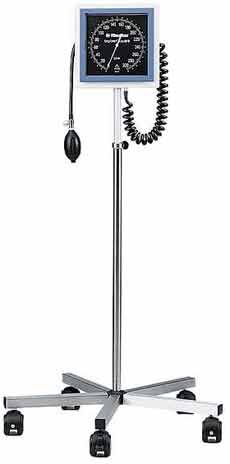Home » Hospital & Durable Medical Equipment » Sphygmomanometer: Measuring the Beat! » Sphygmomanometer: Measuring the Beat!
Sphygmomanometer: Measuring the Beat!

Square Floor Model Sphygmomanometer
Retail Price: $76.89
Your Price: $55.00
 Unit: single
Unit: single

Square Aneroid Wall Blood Pressure Scale
Retail Price: $254.01
Your Price: $160.07
 Unit: single
Unit: single
Using a sphygmomanometer to measure a person's blood pressure is a routine part of every physical exam and has been for decades. The results a sphygmomanometer provides can assess suitability for certain physical activities, predict long-term health risks, help manage many types of medical problems, and determine eligibility for insurance. The use of a sphygmomanometer has been standard practice in the medical profession for over a century and will only continue to be.
The word comes from the Greek sphygmus (pulse) and manometer, an instrument used for measuring the pressure of liquids and gasses. The sphygmomanometer was invented by Samuel Siegfried Karl Ritter von Basch and first appeared in doctors' surgeries in the 1880s. In 1896, Italian pediatrician Scipione Riva-Rocci introduced an easy-to-use variation of the sphygmomanometer that consistently gave reliable results. Harvey Cushing, recognized in the medical profession as the greatest neurosurgeon of the twentieth century, found Riva-Rocci’s sphygmomanometer on a visit to Pavia in 1901 and soon popularized it.
The modern aneroid sphygmomanometer has an inflatable cuff that is wrapped around the upper arm and inflated with air by repeatedly squeezing a rubber bulb. When the pressure in the cuff gets high enough, blood flow in the main artery of the upper arm is cut off. The air is then slowly released and as the pressure falls, a stethoscope is placed over the artery where the sound of rushing blood is heard. These sounds are referred to as Korotkoff sounds. The pressure at which sound is first heard is the systolic pressure. The last sound heard is the diastolic pressure, the pressure at which the sound disappears as the blood resumes normal flow.
In order to obtain accurate blood pressure results using a sphygmomanometer, it’s important to make note of the following:
- The inflatable part of the cuff must be the correct size for the arm. It should cover two thirds of the length of the upper arm. A blood pressure cuff that’s too small will cause an abnormally high blood pressure reading and a low reading may result from too large a cuff. The cuff should be firmly placed with the center of the inflatable part over the brachial artery.
- The cuff must be free of leaks.
- The mercury should be clean and at the zero mark before use.
- During cuff inflation, the mercury should rise smoothly and stop immediately inflation stops.
This procedure with a sphygmanometer is routinely done to screen for hypertension, a major risk factor for serious conditions such as stroke, kidney failure, heart attack, and cardiovascular disease - the leading killer in the United States. The American Heart Association reports that nearly one in three U.S. adults have high blood pressure, but because there are no symptoms, nearly one-third of these people don't even know they have it. In fact, many people have high blood pressure for years without knowing it. The only way to tell if you have high blood pressure is to have your blood pressure checked. With the advent of the digital sphygmomanometer, many people are taking it upon themselves to routinely check their own blood pressures.
The AHA also says that physicians involved in the management of patients with blood pressure problems must accept responsibility for ensuring that adequate instruments are available. They need to educate themselves on the instruments available and encourage the general use of mercury sphygmomanometers as the instrument of choice until others have been better validated.
This is where we come in. Each sphygmomanometer in our inventory is manufactured to the highest standards. Call us toll-free at 1-877-706-4480 for any questions or assistance.















